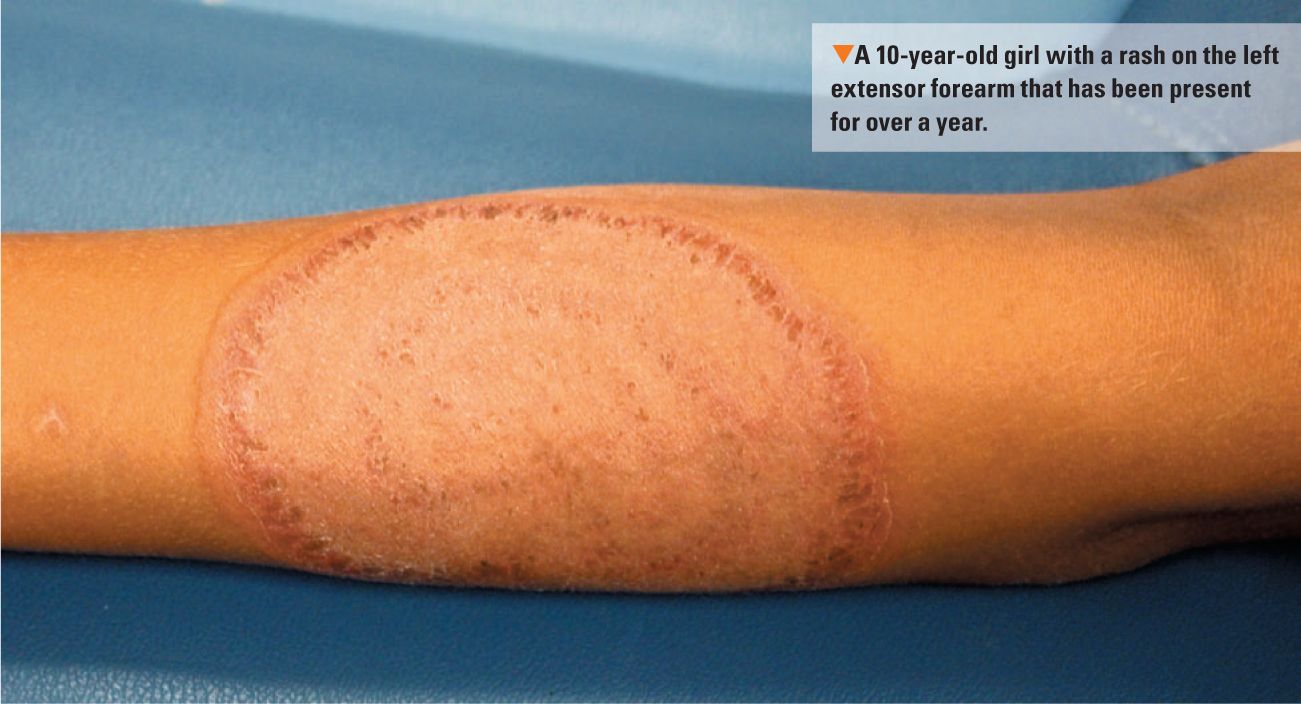Girl’s itchy rash resists repeated treatments
You are asked to evaluate a minimally itchy rash that has been present for over a year on the arm of a 10-year-old girl.

The Case
You are asked to evaluate a minimally itchy rash that has been present for over a year on the arm of a 10-year-old girl. It started as a small red bump and was initially treated with topical antifungal cream without improvement. More recently, the bump was treated with topical steroid cream for 2 months when it began to expand again.
Dermcase Diagnosis: MAJOCCHI GRANULOMA
A potassium hydroxide scraping from the advancing border was negative, as was a fungal culture. Subsequently, a 4-mm skin punch biopsy was performed that showed periodic acid-Schiff-positive fungi within hairs in an endothrix pattern. This is typical of Majocchi granuloma, a dermatophyte infection involving the dermis and subcutaneous tissue causing a deep folliculitis. Another fungal culture from the border grew Trichophyton tonsurans.
Etiology
The commonest cause of Majocchi granuloma in both immunocompetent and immunosuppressed individuals is Trichophyton rubrum.1 Several other organisms also have been reported, mostly in the Trichophyton genera. The dermatophyte may enter into the dermis following occlusion of a hair follicle or damage to the skin.
Clinical findings
Majocchi granuloma has various clinical presentations. In the most common form in normal hosts, a localized area of pruritic grouped erythematous papulopustules or an annular plaque is noted in a hair-bearing area. In immunocompromised patients, there also may be abscesses and subcutaneous nodule formation, although some of these patients may develop only minimal inflammation.2,3
Classically, the infection presents in women who, having shaved their legs, develop papules and pustules in a follicular distribution. Although Majocchi granuloma tends to affect the extremities, scalp, and beard area, it can present anywhere on the body.
Differential diagnosis
Differential diagnosis includes granuloma annulare, acne keloidalis nuchae, eosinophilic pustular folliculitis, and erythema induratum. These can be distinguished by symptoms, clinical findings, culture results, and, when necessary, histologic findings.
Workup
Potassium hydroxide preparations may be negative for hyphae because the fungus may only be present below the stratum corneum.1,4,5 Thus, confirmation of this condition may need to be done via skin biopsy. In order to identify the causative organism, a tissue culture can be performed. When the diagnosis is suspected, empiric therapy may also help confirm clinical diagnosis.
Management
In both immunocompetent and immunocompromised patients, oral antifungals are the preferred treatment. A 2- to 4-week course of oral terbinafine (250mg/day) has been used.6,7 Griseofulvin and itraconazole treatment regimens have also been proposed.8 Topical antifungals alone may be ineffective because of their inability to penetrate the skin deeply enough. There have been cases of treatment via local excision.9,10
The patient
Following diagnosis, the patient was started on oral terbinafine, 250 mg daily for 4 weeks, with rapid improvement in clinical findings.
REFERENCES
1. Smith KJ, Neafie RC, Skelton HG 3rd, Barrett TL, Graham JH, Lupton GP. Majocchi’s granuloma. J Cutan Pathol. 1991;18(1):28-35.
2. Tse KC, Yeung CK, Tang S, et al. Majocchi’s granuloma and posttransplant lymphoproliferative disease in a renal transplant recipient. Am J Kidney Dis. 2001;38(6):E38.
3. Elmets CA. Management of common superficial fungal infections in patients with AIDS. J Am Acad Dermatol. 1994;31(3 pt 2):S60-S63.
4. Feng WW, Chen HC, Chen HC. Majocchi’s granuloma in a 3-year-old boy. Pediatr Infect Dis J. 2006;25(7):658-659.
5. Kim ST, Baek JW, Kim TK, et al. Majocchi’s granuloma in a woman with iatrogenic Cushing’s syndrome. J Dermatol. 2008;35(12):789-791.
6. Gupta AK, Prussick R, Sibbald RG, Knowles SR. Terbinafine in the treatment of Majocchi’s granuloma. Int J Dermatol. 1995;34(7):489.
7. McMichael A, Sanchez DG, Kelly P. Folliculitis and the follicular occlusion tetrad. In: Dermatology. 2nd ed. Bolognia JL, Jorizzo JL, Rapini RP, London, UK: Elsevier Limited; 2008.
8. Gupta AK, Groen K, Woestenborghs R, De Doncker P. Itraconazole pulse therapy is effective in the treatment of Majocchi’s granuloma: a clinical and pharmacokinetic evaluation and implications for possible effectiveness in tinea capitis. Clin Exp Dermatol. 1998;23(3):103-108.
9. Burg M, Jaekel D, Kiss E, Kliem V. Majocchi’s granuloma after kidney transplantation. Exp Clin Transplant. 2006;4(2):518-520.
10. Liao YH, Chu SH, Hsiao GH, Chou NK, Wang SS, Chiu HC. Majocchi’s granuloma caused by Trichophyton tonsurans in a cardiac transplant recipient. Br J Dermatol. 1999;140(6):1194-1196.
Mr Perera is a 5th year medical student at King’s College, London, United Kingdom. Dr Cohen, section editor for Dermcase, is professor of pediatrics and dermatology, Johns Hopkins University School of Medicine, Baltimore. The author and section editor have nothing to disclose in regard to affiliations with or financial interests in any organizations that may have an interest in any part of this article. Vignettes are based on real cases that have been modified to allow the author and section editor to focus on key teaching points. Images also may be edited or substituted for teaching purposes.
Recognize & Refer: Hemangiomas in pediatrics
July 17th 2019Contemporary Pediatrics sits down exclusively with Sheila Fallon Friedlander, MD, a professor dermatology and pediatrics, to discuss the one key condition for which she believes community pediatricians should be especially aware-hemangiomas.